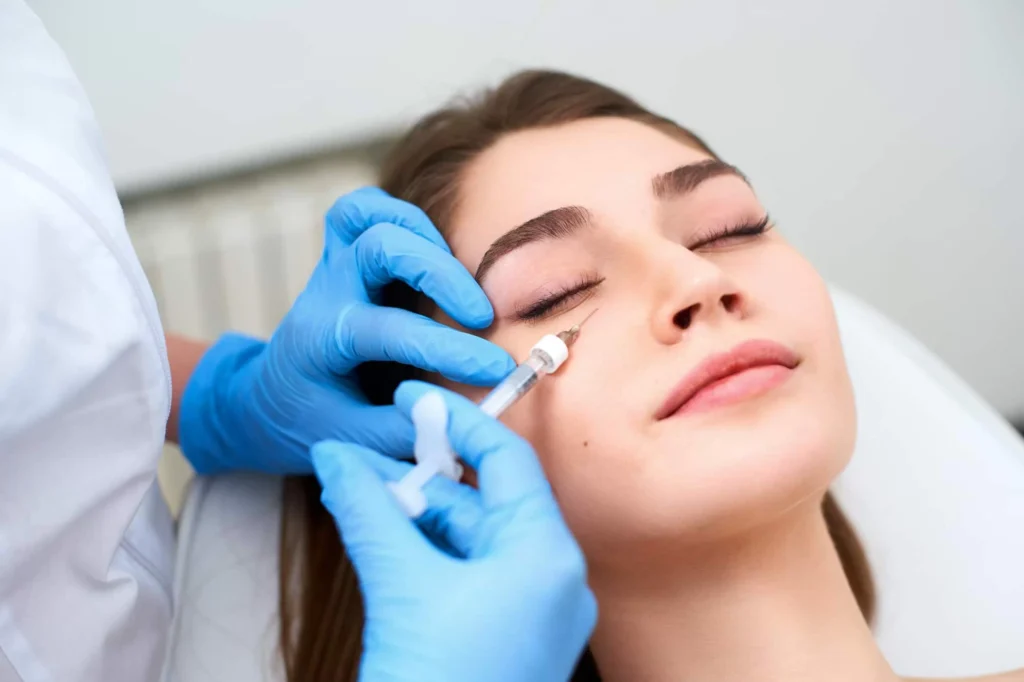Beauty Blog
Under-Eye Fillers: Benefits, Risks & Cost
*Disclaimer: Under-eye fillers are intended for cosmetic treatment by licensed professionals; and can only be sold to special beauty clinics or aesthetic doctors. Unlicensed unprofessional independent use of these products could harm your health.
The first signs of the face skin sagging begin precisely in the area around the eyes. This area is considered incredibly delicate as it reacts sharply to external and internal changes with the first wrinkles: vertical “rays” along the outer corner of the eyes, drooping of the upper eyelid, and dark circles under the eyes.
This zone of the face is the most vulnerable, it lacks subcutaneous fat, and the dermis loses its elasticity faster. So today, we will discuss rescuing treatment for this fragile area – under-eye fillers.
The Science of Under-Eye Filler
Correction in the periorbital area is performed mainly with fillers based on hyaluronic acid. Using another active substance in the product`s base can create additional swelling and other problems. HA has a high degree of safety, blends well with tissues, has a soft texture, does not constrain facial movements, and provides the most natural correction. It is a very versatile solution, able to be used in products such as lip fillers.
Over time, the filler dissolves from the body without a residue. The absence of animal-origin proteins excludes the development of an allergic reaction.
A filler is the best way to address under-eye wrinkles: it fills wrinkles from the inside, moisturizes the skin, and triggers neocollagenesis – the synthesis of elastin and collagen for skin elasticity.
The consistency of filler gels can differ depending on the problems to solve. For example, if the aim is to remove the vascular network around the eyes, small wrinkles or bruises under the eyes, gels with the lightest texture will come to the rescue.
A doctor will use denser gels for deep wrinkles. Correctly selected under-eye filler evenly distributes under the skin and is invisible.
When injected, HA molecules saturate the skin around and under the eyes with moisture, accelerate the regeneration of fibroblasts into collagen and elastin fibers, strengthen the dermis tissues, and make the skin more elastic, smooth, and dense. It is essential to return a healthy color in the area around the eyes due to the activation of all cellular processes.
The effect will be noticeable after the first procedure. Still, it is better to repeat the treatment according to the plan you create for your patient. Repeated treatments are necessary to obtain the accumulative effect of hyaluronic acid injections. As a result, even the eyes themselves begin to shine, and the gaze becomes more open, expressive, and bright.
The cost of these products might differ depending on the manufacturer or where you buy fillers. If you are interested in a specific under-eye filler price, please visit the product page on our website.
Indications for Under Eye Filler And It`s Benefits
After the first introduction of filler under the eyes, it is possible to eliminate such unattractive aesthetic defects as:
- Flaccidity of the skin and soft tissues exhaustion, which leads to the sinking of the eyeballs and the formation of the nasolacrimal furrow;
- Increased dryness with the appearance of wrinkles and folds of varying severity;
- Violation of microcirculation and blood flow leads to couperosis, pigmentation, and the appearance of bruises and dark circles under the lower eyelids.
The benefits of fillers for periorbital wrinkles or dark circles include brightening skin and restoring volume under the eyes. Under-eye fillers address wrinkles and fine lines. As they fill the hollowness under the eyes, they can even out the sunken appearance of the periorbital area.
The main reason to get filler for under-eye circles is to fill a hollowness under the eye called a tear trough. If your patient has dark circles or shadows under your eyes, they might have this type of hollowness or loss of volume in that area.
It’s crucial to distinguish dark circles or puffy eyes caused by loss of volume or an individual`s basic anatomy (both can be hereditary) from wrinkles or dark circles under the eyes caused by hyperpigmentation in the area.
The dermal filler won’t help if a patient has true natural pigmentation. In other words, if the skin under a person`s eye is darker because of their natural complexion or prior sun damage, dermal fillers, unfortunately, won’t change it.
If, however, this darkness results from skin laxity from aging or genetics, adding an under-eye filler can provide a solution for filling the hollow areas of dark circles without causing any puffiness, thereby creating a more even and volumized appearance.
Under-eye filler based on HA offers numerous benefits, including:
- Providing natural-looking results that enhance the appearance;
- Biocompatibility, as HA is naturally present in the human body and absorbs over time;
- Being reversible using hyaluronidase, which dissolves the filler in case of any issues;
- Fillers are easy to manipulate during treatment, allowing for precise placement and smooth outcomes;
- Providing immediate results with minimal downtime;
- Addressing under-eye circles and a hollow appearance, creating a more youthful and rested look;
- Moisturizing and hydrating the skin, improving elasticity and suppleness;
- Helping to prevent signs of aging, such as wrinkles, fine lines, and sagging skin, by stimulating collagen production and promoting skin renewal.
Considerations for Treating Under-Eye Filler Patients
On pretreatment consultation, the cosmetologist studies the degree of aesthetic defects in the periorbital area; they then determine indications and contraindications for contour plastic surgery.
Doctors need to discuss the following topics with their patients:
- Medical and family history, including all allergies, skin, and neurological conditions;
- Medication that the patient takes (NSAIDs or blood thinners can increase bruising);
- Discussing what type of dermal filler will be appropriate to use;
- Side effects and possible complications.
Contraindications to the procedure:
- Individual intolerance of the components of the under-eye filler;
- Epilepsy;
- Recently performed blepharoplasty or peelings;
- Tendency to scarring;
- Autoimmune diseases;
- Oncological and blood diseases;
- Various infections, skin inflammations;
- Pregnancy and lactation;
- Glaucoma;
- Diabetes;
- Kidney failure;
- Young age.
Hyaluronic-based fillers have practically no side effects and are harmless to the body if you follow the rules of use and indicated contraindications.
Under-eye fillers` side effects could have the following symptoms around the puncture sites of soft tissues:
- swelling,
- edema,
- hematomas,
- itching and redness,
- allergic reaction.
These risks are typical for any injection manipulation.
Such complications do not require medical attention and pass after a few days.
Administering Under Eye Filler
A doctor can make a treatment plan for the injections once they have decided that the patient fits the treatment criteria and has no contraindications.
Immediately before the procedure, a doctor conducts mandatory disinfection of the selected area, applies an anesthetic cream, and only after that injects the filler with the thinnest needles. If the drug contains lidocaine, there is no need for an anesthetic cream.
Doctors inject an under-eye filler according to the conventional approach – parallel to the wrinkle, and in a progressive method – perpendicularly to the wrinkle to create a frame barrier and fix the result.
There are two different techniques for injecting fillers. Some doctors prefer the traditional tiny needles that come with the product, while others prefer to use a cannula. A cannula is a plastic tube that can be inserted directly into veins or tissue. The tip of the cannula slides between the layers of tissue without posing a risk of nerve damage around the eye area.
Using the needle alone is the more conventional method, while the cannula acts as a blunt straw that allows the needle to pass through the tube, reducing the need for multiple needle entry points.
While some experts argue that using a cannula is a safer approach, leading to less swelling, bruising, and infection risks: being a skilled medical professional is the most critical factor in injecting filler under the eye. An experienced board-certified dermatologist or cosmetic surgeon with expertise in the delicate anatomy around the eyes can provide optimal results while minimizing the risks.
The procedure takes 30-40 minutes maximum, allowing the patient to return to their usual lifestyle immediately.
Aftercare instructions for the patients:
- Refrain from strenuous activity for 1-2 days;
- Avoid sleeping face down;
- Periodically apply ice for the first 1-2 days after filler treatment;
- Avoid direct sun exposure and tanning beds.
Conclusion
Dermal injectables, with a range of areas of use, such as Fillmed, which is used primarily for the lip area, help restore volume loss and a youthful appearance of the periorbital area. Under-eye fillers can correct defects that cannot be removed by Botulinum toxins, and mesotherapy, for example, cannot remove them. They allow quick recovery after the session (the patient can immediately go home) and a short rehabilitation period (10 days maximum).
What attracts patients the most is achieving the effect in one session and the longevity of the result (6-18 months).
FAQ
How long does under-eye filler last?
If the patient follows the cosmetologist’s recommendations, they can preserve the result of filler treatment for a relatively long period (up to 1 year or more, depending on the filler).
Are under-eye fillers a good idea?
Under-eye filler may seem like a drastic choice for the patient. However, it may be one of the few things that can change the appearance of their under-eye area, depending on what’s causing their preorbital problems.
What are the cons of under-eye fillers?
Under-eye fillers have the following cons:
- Possible swelling or bruising around the injection site;
- They slow down natural HA production;
- The price of under-eye fillers is relatively high and usually not covered by insurance;
- Risk of infection and deformity if proper technique is not used.

